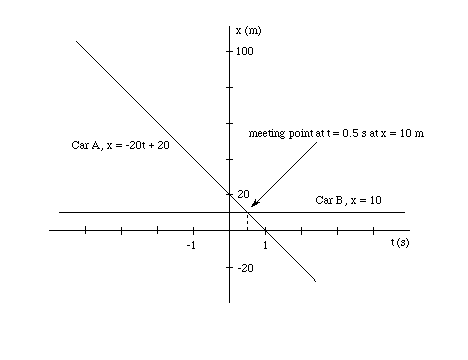
Question
Physics 211 - This question is a continuation of the May 30 question. Remember that in that question we had one car whose position x at time t was given by x = -20t + 20. Let us call this Car A. Suppose there is a second car, Car B, which is parked on the road at x = 10 m.
(a) At what time does Car A pass Car B? Determine the answer both graphically and analytically. (Graphs. Analytical Geometry.)
Answer
At what time t do the x-values of the two cars coincide? To find this time, we equate the x-values of the two cars, i.e., we let x = 10 in x = -20t + 20. Thus,
First subtracting 20 from both sides of the equation and then dividing by -20 isolates t:
Thus Car A passes Car B at t = 0.5 s. The following graph agrees with this result. Since Car B is at rest at x = 10 m, the graph of its motion is a horizontal line at x = 10 m. This line intersects the graph of x = -20t + 20 at t = 0.5 s and x = 10 m.

(b) Show the graphs of the motions of Cars A and B in the reference frame of Car A, i.e., on a pair of x',t axes where the x'-axis is the position axis relative to which Car A is at rest. As in the May 30 question, Car A is at x' = 20 m. Draw the x'-axis vertical and the t-axis horizontal.
Is the intersection point of the x' vs. t graphs for the two cars consistent with the answer in part (a)?(Graphs. Analytical Geometry.)
Answer
We need to determine the equations that relate the x'-positions of the two cars to the time t. Then we can graph these equations on a pair of x',t axes.
For Car A, the equation is simply x' = 20 m. For Car B, we must translate the equation x = 10 m into an equation relating x' to t.
In the answer to Part (a) of the March 30 question, it was shown that the origin of the frame in which Car A is at rest, i.e., the point x' = 0, moves in the road's frame according to the equation x = -20t.
Thus, if at time t the point x' = 0 is at x = -20t, then the point x = 10 has a displacement of 10 - (-20t) = 10 + 20t from the point x' = 0. Therefore the point x' = 0 has the x-coordinate x = 10 + 20t at time t. The following diagram illustrates this situation.

The following diagram shows the graphs of the two equations x' = 20 and x' = 10 + 20t.

As you can see, the intersection point is again at t = 0.5 s.